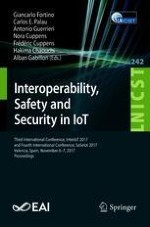2018 | Buch
Interoperability, Safety and Security in IoT
Third International Conference, InterIoT 2017, and Fourth International Conference, SaSeIot 2017, Valencia, Spain, November 6-7, 2017, Proceedings
herausgegeben von: Prof. Giancarlo Fortino, Prof. Carlos E. Palau, Antonio Guerrieri, Nora Cuppens, Frédéric Cuppens, Prof. Hakima Chaouchi, Alban Gabillon
Verlag: Springer International Publishing
Buchreihe : Lecture Notes of the Institute for Computer Sciences, Social Informatics and Telecommunications Engineering
